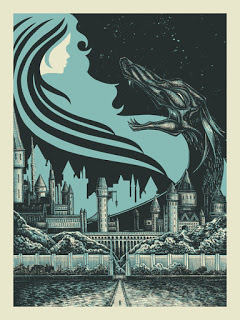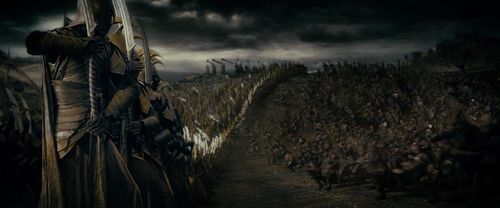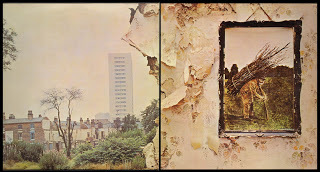The Battle of Evermore - Led Zeppelin
 In "The Battle of Evermore" (LZ4), Robert Plant introduces the Queen of Light, who is central to "Stairway To Heaven." Like "Stairway" and so much of Zeppelin's imagery, "Evermore" is influenced by Celtic mythology, particularly the fifteenth and sixteenth century Anglo-Scottish wars. Most Zeppelin enthusiasts know the story of the song's creation — Jimmy Page casually picking up John Paul Jones' mandolin at the band's house-cum-studio, Headley Grange, in East Hampshire. "On 'The Battle of Evermore,' a mandolin was lying around," Page said to Guitar Player in 1977. "It wasn't mine, it was Jonesey's. I just picked it up, got the chords, and it sort of started happening. I did it more or less straight off. But, you see, that's fingerpicking again, going back to the studio days and developing a certain amount of technique – at least enough to be adapted and used. My fingerpicking is a sort of cross between Pete Seeger, Earl Scruggs, and total incompetence." Sound engineer Andy Johns said of the recording: "The band was sitting next to the chimney in Headley, drinking tea, when Jimmy grabbed a mandolin and started playing. I gave him a microphone and stuck a Gibson echo on his mandolin. Jimmy had brought this stuff before and had asked me to take a look at it. Suddenly Robert started singing and this amazing track was born from nowhere." Sandy Denny, the one-time singer for Fairport Convention, a Brit-folk band, was asked to play the Queen of Light's role. whose feminine strength and wisdom grounds the masculine warrior, Plant. She sings of the coming battle and urges on the prince with lines like "Dance in the dark night, sing to the morning light" and "Throw down your plow and hoe, race now to my bow." The archetype re-emerges in "Stairway to Heaven" as the May Queen and some maintain a connection to "Going to California" (itself an homage to Joni Mitchell).
In "The Battle of Evermore" (LZ4), Robert Plant introduces the Queen of Light, who is central to "Stairway To Heaven." Like "Stairway" and so much of Zeppelin's imagery, "Evermore" is influenced by Celtic mythology, particularly the fifteenth and sixteenth century Anglo-Scottish wars. Most Zeppelin enthusiasts know the story of the song's creation — Jimmy Page casually picking up John Paul Jones' mandolin at the band's house-cum-studio, Headley Grange, in East Hampshire. "On 'The Battle of Evermore,' a mandolin was lying around," Page said to Guitar Player in 1977. "It wasn't mine, it was Jonesey's. I just picked it up, got the chords, and it sort of started happening. I did it more or less straight off. But, you see, that's fingerpicking again, going back to the studio days and developing a certain amount of technique – at least enough to be adapted and used. My fingerpicking is a sort of cross between Pete Seeger, Earl Scruggs, and total incompetence." Sound engineer Andy Johns said of the recording: "The band was sitting next to the chimney in Headley, drinking tea, when Jimmy grabbed a mandolin and started playing. I gave him a microphone and stuck a Gibson echo on his mandolin. Jimmy had brought this stuff before and had asked me to take a look at it. Suddenly Robert started singing and this amazing track was born from nowhere." Sandy Denny, the one-time singer for Fairport Convention, a Brit-folk band, was asked to play the Queen of Light's role. whose feminine strength and wisdom grounds the masculine warrior, Plant. She sings of the coming battle and urges on the prince with lines like "Dance in the dark night, sing to the morning light" and "Throw down your plow and hoe, race now to my bow." The archetype re-emerges in "Stairway to Heaven" as the May Queen and some maintain a connection to "Going to California" (itself an homage to Joni Mitchell).  The Battle of PellanorLord of the Rings enthusiasts (Return of the King) see a connection between the Battle of Evermore and the Battle of Pelennor, and for good reason: sources for Tolkien would undoubtedly be similar. "At last the sun is shining,/ The clouds of blue roll by" conjures up Sauron's army as the sky darkened. As Sauron inevitably loses the battle, the light returns. Equal parts don't fit, the Angels of Avalon, for instance, emerge from the legends of Merlin and King Arthur. Interestingly, Avalon is Latin for the Place of Apples, which shows Plant doing his research as he deconstructs the construct: "I'm waiting for the angels of Avalon,/ waiting for the eastern glow. The apples of the valley hold the seeds of happiness." In many ways the song, and in particular the the title, conjure up the human condition, struggle in the face of battle, whether real or emotional, with hope eternal – the tireless ideology of humanity that good will prevail.
The Battle of PellanorLord of the Rings enthusiasts (Return of the King) see a connection between the Battle of Evermore and the Battle of Pelennor, and for good reason: sources for Tolkien would undoubtedly be similar. "At last the sun is shining,/ The clouds of blue roll by" conjures up Sauron's army as the sky darkened. As Sauron inevitably loses the battle, the light returns. Equal parts don't fit, the Angels of Avalon, for instance, emerge from the legends of Merlin and King Arthur. Interestingly, Avalon is Latin for the Place of Apples, which shows Plant doing his research as he deconstructs the construct: "I'm waiting for the angels of Avalon,/ waiting for the eastern glow. The apples of the valley hold the seeds of happiness." In many ways the song, and in particular the the title, conjure up the human condition, struggle in the face of battle, whether real or emotional, with hope eternal – the tireless ideology of humanity that good will prevail. The cryptic ideology continues throughout the LP, and indeed in the cover itself. The symbols, or runes, on Led Zeppelin IV represent each member of the band, as well as Sandy Denny. Page decided that the next Led Zeppelin album would not have a title, but would instead feature four hand-drawn symbols. "We decided that on the fourth album, we would deliberately play down the group name, and there wouldn’t be any information whatsoever on the outer jacket. After all this crap that we'd had with the critics, I put it to everybody else that it'd be a good idea to put out something totally anonymous."
 Zoso, Page's symbol represents Saturn, which rules over Page's astrological sun sign, Capricorn. John Paul Jones' symbol, which he chose from Rudolph Koch's Book of Signs, is a single circle intersecting the Vesica Pisces (a triquetra, Cherubim found on the Ark of the Covenent) and represents a person who possesses both confidence and competence. John Bonham's three interlocking rings, picked by the drummer from the same book, represents the trinity of mother, father and child. Plant’s symbol is the feather of Ma'at, the Egyptian goddess of justice and fairness, and is the emblem of a writer. The fifth, smaller symbol, three intersecting, inverted pyramids (the Godhead), was chosen by guest vocalist Sandy Denny and appears in the credits on the inner sleeve.
Zoso, Page's symbol represents Saturn, which rules over Page's astrological sun sign, Capricorn. John Paul Jones' symbol, which he chose from Rudolph Koch's Book of Signs, is a single circle intersecting the Vesica Pisces (a triquetra, Cherubim found on the Ark of the Covenent) and represents a person who possesses both confidence and competence. John Bonham's three interlocking rings, picked by the drummer from the same book, represents the trinity of mother, father and child. Plant’s symbol is the feather of Ma'at, the Egyptian goddess of justice and fairness, and is the emblem of a writer. The fifth, smaller symbol, three intersecting, inverted pyramids (the Godhead), was chosen by guest vocalist Sandy Denny and appears in the credits on the inner sleeve. Narrator: The Queen of Light took her bow and then she turned to goThe Prince of Peace embraced the gloom and walked the night aloneQueen of Light: Oh, dance in the dark night, sing to the morning lightNarrator: The Dark Lord rides in force tonight, and time will tell us allQueen of Light: Oh, throw down your plow and hoe, race now to my bowNarrator: Side by side we wait the might, of the darkest of them all
I hear the horses thunder down in the valley belowI’m waiting for the angels of Avalon, waiting for the eastern glowThe apples of the valley hold the seeds of happinessThe ground is rich from tender care, which they do not forget, no, no
Queen of Light: Dance in the dark night, sing to the morning lightNarrator: The apples turn to brown and black, the tyrant’s face is redQueen of Light: Oh, war is the common cry, pick up your swords and flyNarrator: The sky is filled with good and bad, mortals never know
Oh well, the night is long, the beads of time pass slowTired eyes on the sunrise, waiting for the eastern glow
Narrator: The pain of war cannot exceed the woe of aftermathThe drums will shake the castle wall, the Ringwraiths ride in black, ride onQueen of Light: Sing as you raise your bow, shoot straighter than beforeNarrator: No comfort has the fire at night that lights the face so coldQueen of Light: Oh, dance in the dark night, sing to the morning lightNarrator: The magic runes are writ in gold to bring the balance back, bring it back
At last the sun is shining, the clouds of blue roll byWith flames from the dragon of darkness, the sunlight blinds his eyes
Published on November 15, 2018 04:54
No comments have been added yet.



